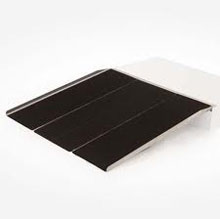
Access Ramps Resources
- Home
- Types of Access Ramps
- Access Ramps for Vehicles
- Access Ramps for Wheelbarrows
- Access Ramps for Wheelchairs
- Bariatric Access Ramps
- Folding Access Ramps
- Modular Access Ramps
- Multi-Fold Access Ramps
- Permanent Access Ramps
- Roll up Access Ramps
- Single-Fold Access Ramps
- Solid Access Ramps
- Suitcase Access Ramps
- Telescoping Access Ramps
- Temporary Access Ramps
- Threshold Access Ramps
- Track Access Ramps
Bariatric Access Ramps
Bariatric access ramps are access ramps that are capable of supporting more weight than the average access ramp. This is because bariatric access ramps are catered more specifically for bariatric wheelchairs, powerchairs or mobility scooters. Bariatric wheelchairs or mobility scooters itself are designed to accommodate users who exceed the weight capacities of standard wheelchairs. A standard bariatric wheelchair can typically accommodate users who are more than 350 pounds. Therefore bariatric access ramps have to have a weight capacity of at least 450-500 pounds taking into consideration the weight of the user as well as the wheelchair or mobility scooter. Thus, bariatric access ramps are a heavier duty type of access ramp that can take on considerably more weight than normal run of the mill access ramps.
Like any standard access ramp, bariatric access ramps are also categorized into several types, such as permanent or semi-permanent access ramps and portable access ramps. The major difference would have to be the weight capacity as bariatric access ramps are capable of taking so much more weight than normal access ramps. Because of this, the price for bariatric access ramps is also considerably more than normal access ramps. The simplest of bariatric access ramps can cost upwards of USD $200.00 to several thousands of dollars depending on the type and maximum weight capacity.
Permanent access ramps can generally take on the weight of a bariatric wheelchair or mobility scooter as well as its user so there are normally no specialized permanent bariatric access ramp. For semi-permanent access ramps such as threshold access ramps, modular access ramps and some folding access ramps, there are designs that cater especially for bariatric wheelchair or mobility scooter users. However, bariatric access ramps are usually platform-like and consists of panels that are either welded together for extra stability or in some cases these panels can be folded like any other folding access ramps. Nevertheless, the hinges on these suitcase-like bariatric access ramps are usually sturdier or in some instances are screws to ensure that the hinges do not break or come apart during use. The hinges are one of a folding access ramp’s weak points and in view of the extreme weights that a bariatric access ramp is subjected to, should be reinforced if possible. Also, bariatric access ramps are generally designed to be wider than the customary access ramp.
Portable bariatric access ramps are usually full platforms. Portable bariatric access ramps do not come in pairs like track access ramps as the needs of a bariatric wheelchair or mobility scooter far exceeds the specifications two separate tracks can offer. Portable bariatric access ramps can usually be folded either in half or more. This is especially useful as portable bariatric access ramps tend to be comparatively bulkier than the standard portable access ramps that is primarily designed for compactness and easy portability and storage.
While portable bariatric access ramps may not be as compact as their standard portable access ramp counterparts, they can still be transported to and from the vehicle. Painstaking care should be given in the unfolding and setting up of bariatric access ramps as the caregiver should make sure that the hinges are securely screwed on or fastened.
